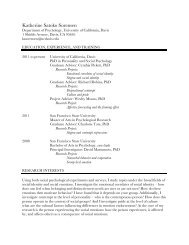The Psychology of Creativity:
The Psychology of Creativity:
The Psychology of Creativity:
You also want an ePaper? Increase the reach of your titles
YUMPU automatically turns print PDFs into web optimized ePapers that Google loves.
History <strong>of</strong> <strong>Creativity</strong> Research 9<br />
eminence, or genius, will run in families. Hence, to test this prediction, Galton devised the pedigree method, a<br />
technique still important in behavioral genetics. In particular, he collected distinguished achievers in a diversity <strong>of</strong><br />
domains and then calculated that notable pedigrees occurred with a probability far exceeding the chance baseline.<br />
Because Galton’s calculations included illustrious poets, composers, painters, and scientists, creative genius seems<br />
to be born, not made.<br />
Needless to say, not everyone believed that Galton (1869) had made a totally convincing case. For<br />
instance, Alphonse de Candolle (1873) countered Galton’s genetic determinism by publishing an empirical study <strong>of</strong><br />
the political, social, economic, and cultural environments that best support the emergence <strong>of</strong> great scientists. Galton<br />
responded at once with the 1874 book English Men <strong>of</strong> Science: <strong>The</strong>ir Nature and Nurture (Hilts, 1975). For four<br />
reasons, this constitutes another masterpiece in creativity studies. First, this is the first investigation that attempted<br />
to study highly creative individuals directly, in this case scientists <strong>of</strong> sufficient stature to be elected Fellows <strong>of</strong> the<br />
Royal Society. <strong>The</strong> eminent creators in Hereditary Genius had been studied indirectly, using published biographical<br />
and historical materials. Second, Galton asked these notables to respond to a questionnaire, thereby introducing a<br />
new technique in psychology. Third, to investigate the developmental factors underlying scientific creativity, the<br />
questionnaire included many variables for the first time, such as the birth order and educational experiences. Fourth,<br />
and as is apparent from the book’s subtitle, Galton inaugurated the “nature-nurture issue” as one <strong>of</strong> the central<br />
empirical and theoretical problems not only in the study <strong>of</strong> creativity, but in developmental psychology in general.<br />
To what extent are individual differences, whether in creativity or otherwise, a function <strong>of</strong> genetic endowment and<br />
to what extent are they the upshot <strong>of</strong> environmental influences?<br />
After this second book, Galton’s place in the history <strong>of</strong> creativity research fades in the background. He<br />
became preoccupied with other problems. For instance, he tried to gauge individual differences in natural ability<br />
directly, devising instruments that ended up being totally useless (Galton, 1883). After English Men <strong>of</strong> Science his<br />
main contributions to the creativity research were methodological. Most notably, Galton initiated statistical analyses<br />
that led to the development <strong>of</strong> the correlation coefficient, and he introduced the use <strong>of</strong> identical twins to assess the<br />
heritability <strong>of</strong> various traits. Yet it was left to others to apply these methodological advances to creativity studies.<br />
Clinical Science<br />
Aristotle is reputed to have claimed, “those who have become eminent in philosophy, politics, poetry, and<br />
the arts have all had tendencies toward melancholia” (quoted in Andreasen & Canter, 1974, p. 123). This claim has
















